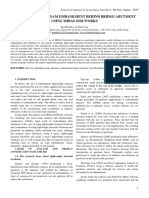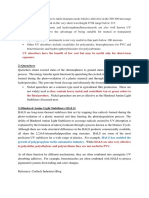Baud Rate Generator:: Homework Assignment # 4
Baud Rate Generator:: Homework Assignment # 4
Uploaded by
Badrinath BalasubramanianCopyright:
Available Formats
Baud Rate Generator:: Homework Assignment # 4
Baud Rate Generator:: Homework Assignment # 4
Uploaded by
Badrinath BalasubramanianOriginal Title
Copyright
Available Formats
Share this document
Did you find this document useful?
Is this content inappropriate?
Copyright:
Available Formats
Baud Rate Generator:: Homework Assignment # 4
Baud Rate Generator:: Homework Assignment # 4
Uploaded by
Badrinath BalasubramanianCopyright:
Available Formats
ECE667
Homework Assignment # 4 Due Monday April 26th by 12.00 noon in TAs mailbox in DL205
Spring 2010
In this assignment, you will design the necessary hardware components to implement a simple remote control module (Though for our purposes, the unit will be connected to the receiving unit through a pair of wires). In addition to the keypad scanner you have already designed, you will also add a design for an Asynchronous Serial Transmitter capable of transmitting data at one of four selectable bitrates. Transmission rate selection will be done through a Baud-Rate Generator, which is basically just a selectable version of the frequency divider designed in the previous homework. Finally, you will need to design a System Controller for the remote control module to coordinate the signals from the system components so that the keys pressed on the keypad are transmitted serially through the transmitter.
Baud Rate Generator:
The next clock generator you will design will be the baud rate generator for the asynchronous serial transmitter of Project #2. The baud rate at which data will be transmitted will be one of four possible bit rates, and should be selectable by your design. The following table shows the clock frequencies your circuit should generate:
Rate Select 0 (00) 1 (01) 2 (10) 3 (11)
Bit Rate 1200 bits/s 2400 bits/s 4800 bits/s 9600 bits/s
Clock Freq. 1200 Hz 2400 Hz 4800 Hz 9600 Hz
Basically, this circuit does the same exact thing as the 1 kHz clock generator from the previous homework assignment, with the added capability of a selectable frequency. The block diagram for this circuit should look as shown below:
From External Oscillator External Baud Rate Selection
4MHZ S1 S0
BAUD_CLK
To Async. Transmitter
Follow the same guidelines used in the design of the previous clock divider, and clearly show/explain the operation of the circuit.
ECE667
Homework Assignment # 4
Spring 2010
Asynchronous Serial Transmitter: The main function of the transmitter is to take parallel data from your circuit, and transmit this data bit by bit to a serial receiver. The baud-rate generation circuit you designed above will determine the rate at which this data will be sent. The transmitter should be designed to transmit in the standard RS-232 protocol. The format for data in this protocol is shown below.
LSB Start Bit 8 Data Bits MSB P Stop Bit
While the standard sets aside the eighth data bit as a parity bit (used in transmission/reception error detection), we will simplify our design by excluding parity calculation, and simply send eight bits of data. The block diagram for your transmitter design should look as shown below:
8 Parallel Data In Transmission Enable Baud Rate Clock P[7..0] TX CLK TX_RDY TX_DATA To System Controller Serial Data Transmission
Basically, eight bits of parallel data will be placed on lines P(7:0), and then the device will be enabled by setting TX high. Once enabled, output TX_DATA will serially transmit the data placed on the parallel inputs P(7:0) by first sending out bit P0 (the least significant bit) for one complete baud clock cycle. Each consecutive cycle after will place the next sequential bit on the data line until the most significant bit, P7, has been transmitted. However, in order to make our signal conform to the RS-232 protocol, the eight bits of data must be preceded by a start bit and followed by a stop bit. In order to understand the function of the start and stop bits, we must examine how we would like the TX_DATA output to behave when the device is not active. The following waveforms illustrate the desired circuit outputs based on the input signals:
ECE667
Homework Assignment # 4
Spring 2010
BAUD CLK
P(7:0)
Don't Care
TXMIT
TX_DATA
TX_RDY
The waveforms above show how the device should operate when it is not enabled (when TXMIT = 0). Since the device is not operating, we really don't care what is placed on the parallel inputs, as it shouldn't really make any difference. The output TX_DATA is to be maintained in a high state, also known as the stop condition. The receiver on the other end will recognize this condition, and understand that no data is being sent. The output TX_RDY is used to tell let any external devices know the state of the transmitter. In the waveform above, TX_RDY is maintained high, signaling that the transmitter is ready to accept a byte from the parallel inputs. To transmit our parallel data, we could just begin sending our bits after enabling the transmitter, but what if the first bit to be sent (P0) is a 1. How will the receiver know that the transfer has begun? Or what if the parallel data is all 1s (FF in hexadecimal). In this case the receiver wouldn't even know that a transfer was even attempted. To solve this problem, we will start all transmissions with a low signal for one clock cycle. This is known as the start bit. The receiver on the other end (in the RS-232 protocol) will interpret this to mean that the next 8 bits after the start bit will contain serial data in order from least to most significant bits. Following this data, the serial line will again enter the stop condition, signaling the end of the transmission. The waveforms on the next page illustrate the operation of the transmitter with the start and stop bits included.
ECE667
Homework Assignment # 4
Spring 2010
BAUD CLK
P(7:0)
9Dh
3Fh
TXMIT
TX_DATA
Start
Stop
TX_RDY
We begin by setting the parallel data on the P(7:0) inputs. For this example, we would like to send 9Dh (or 1001 1101 in binary). The transmitter is triggered on a positive edge of the baud clock while TXMIT is high. Once triggered, the start bit is placed on TX_DATA, and TX_RDY goes low signaling that the device is currently busy. Note that once the transmission has begun, it shouldn't matter if the parallel inputs change during the transfer. The transmitter should still transmit the byte it started (9Dh). The parallel data is then serialized and sent in the next eight baud-clock cycles in order from least to most significant bits. Once all of the data bits have been sent, TX_RDY goes high again (signaling that the device is ready to transmit the next byte), and TX_DATA returns to the stop condition. System Controller: Now that we have both a keypad scanner and a transmitter, we would like to combine these components so that when we press a key, the code for that key is sent serially through the transmitter. Design a system controller that will accomplish this. The block diagram for your controller should look as shown below.
Transmitter Status Keypad Scanner Status 4 MHz Clock Signal
TX_RDY KP_VALID 4M_CLK
TX_TXMIT
To Transmitter Enable
When the system begins operation, transmission will initially be disabled (TX_TXMIT = 0). When the controller detects that a valid key is currently pressed (KP_VALID = 1), the controller
ECE667
Homework Assignment # 4
Spring 2010
should then allow only one copy of the current key code to be transmitted by enabling the transmitter (TX_TXMIT = 1). (Hint: This can be done by monitoring the KP_VALID signal). Assume that the key outputs from the keypad scanner are connected directly to the low four bits of the transmitter. The high four bits , P(7:4), should be set to "0011" (or 3 in hexadecimal). This will set our transmitter to send the ASCII column of numbers to the receiver, and aid in verifying the operation of the unit once the design is programmed into the CPLD.
To Hand In:
Simulation of the Baud Rate Generator can take a good amount of time on a slow PC. However, it is necessary to show that the design is producing the proper clock signals. Turn in your graphical design for the Baud Rate generator along with the following results You will need to turn in a total of four simulation waveforms for this device, one for each of the frequencies generated (show the select signals on the baud rate generator waveforms). Select the end time of these simulations accordingly so that one full period of the clock waveform is shown for each case. You will not be able to divide the clock into the exact desired frequencies. Provide a detailed analysis of the error associated with each frequency (i.e find the % error from the ideal frequency) Clearly explain the operation of your circuits, and provide equations where they are relevant. Provide a schematic (either sketch or in Quartus II) for all circuits.(Asynchronous serial transmitter, System Controller) You may use any of the macrofunctions included in the Quartus II software package in your designs, but clearly explain how you are implementing these parts. If you decide not to use these parts, clearly show how you designed each of the components. You must include a state diagram for your system controller, as well as the supporting tables, equations, etc.
You might also like
- Buddy API DocsDocument118 pagesBuddy API DocsRaj ChavanNo ratings yet
- Kettler SM 9150-75Document22 pagesKettler SM 9150-75Horatiu PetrescuNo ratings yet
- 16 Bit CalculatorDocument17 pages16 Bit CalculatorPankaj JaiswalNo ratings yet
- UART ArchitectureDocument23 pagesUART ArchitectureEdgar Mugabi Tusuubira100% (4)
- Literature Review TECHDocument7 pagesLiterature Review TECHSoma ShekarNo ratings yet
- UART LibraryDocument9 pagesUART LibraryRey Del Castillo Luar Jr.100% (3)
- (Chapter 22) Fundamental Concepts of Data Communications (149-166) PDFDocument18 pages(Chapter 22) Fundamental Concepts of Data Communications (149-166) PDFSam Dy100% (1)
- Operation Manual PDFDocument285 pagesOperation Manual PDFpriyaNo ratings yet
- BS-300/BS-320 Chemistry Analyzer Service Manual: Intellectual Property StatementDocument42 pagesBS-300/BS-320 Chemistry Analyzer Service Manual: Intellectual Property StatementDerdar FahimNo ratings yet
- Serial Communication 2Document31 pagesSerial Communication 2jaigodara100% (1)
- TXQ 13012 BC 6800&BC 6600 PDFDocument2 pagesTXQ 13012 BC 6800&BC 6600 PDFDenis PereiraNo ratings yet
- LCD 16 X 2Document9 pagesLCD 16 X 2Pradeev Balakrishnan100% (1)
- TWSGuideDocument948 pagesTWSGuidevmmg5418860No ratings yet
- TXQ 13004 BC 6800&BC 6600 PDFDocument2 pagesTXQ 13004 BC 6800&BC 6600 PDFDenis PereiraNo ratings yet
- RS-232 Cabling TutorialDocument13 pagesRS-232 Cabling TutorialAlvin CheangNo ratings yet
- MATLAB Applications of Trading Rules and GARCH With Wavelets AnalysisDocument11 pagesMATLAB Applications of Trading Rules and GARCH With Wavelets Analysisgiovanis3202No ratings yet
- ADC (Analog To Digital Converter) in ARM LPC2148Document7 pagesADC (Analog To Digital Converter) in ARM LPC2148Ravi RajanNo ratings yet
- EHT5 Product Manual PRDocument93 pagesEHT5 Product Manual PRAlexeyNo ratings yet
- 400 Series: Owner's ManualDocument41 pages400 Series: Owner's Manualanilr008No ratings yet
- Case v67Document342 pagesCase v67FantahunNo ratings yet
- Medical MysteriesDocument82 pagesMedical MysteriesSai Kumar KonukuNo ratings yet
- UARTDocument26 pagesUARTShantanu Tripathi100% (2)
- 11U Pract Test StoichDocument12 pages11U Pract Test StoichNabila HanimNo ratings yet
- Flow Cytometric MorphologyDocument12 pagesFlow Cytometric MorphologyReynaldo MacarioNo ratings yet
- 5300 Operation Manual (v1.5)Document486 pages5300 Operation Manual (v1.5)Phan Quan100% (1)
- JSN SR04T 2.0Document4 pagesJSN SR04T 2.0JederVieira100% (1)
- How To Perform and Interpret An Exercise TestDocument48 pagesHow To Perform and Interpret An Exercise TestBilal AfridiNo ratings yet
- Firebird VDocument6 pagesFirebird VPriyanshu Gupta100% (2)
- RS232Document26 pagesRS232Pratesh Kumar Reddy100% (3)
- Agribot Project PresentationDocument21 pagesAgribot Project Presentationumaiya1990100% (1)
- List of Tor's IP AddressDocument112 pagesList of Tor's IP AddressDody SubaktiyoNo ratings yet
- PIC Timer 0 Calculation ExampleDocument3 pagesPIC Timer 0 Calculation Examplef.last100% (1)
- AVR Microcontroller: Prepared By: Eng. Ashraf DarwishDocument27 pagesAVR Microcontroller: Prepared By: Eng. Ashraf DarwishHectorLopez100% (2)
- BC 2300 ServiceDocument10 pagesBC 2300 ServiceBio AllianceNo ratings yet
- Nec Ir For PicDocument14 pagesNec Ir For Picsudhakar5472100% (2)
- Scrolling 16 2 Led in PICDocument23 pagesScrolling 16 2 Led in PICmalhiavtarsingh100% (3)
- Report On Ultrasonic Distance MeterDocument39 pagesReport On Ultrasonic Distance MeterVijendra Solanki100% (2)
- StopWatch CDocument6 pagesStopWatch CInderJeet Gehlot100% (1)
- Digital Temperature Meter Using PIC16F688Document3 pagesDigital Temperature Meter Using PIC16F688Bhuvaneswaran VutwobwnNo ratings yet
- Ping Ultrasonic Range FinderDocument5 pagesPing Ultrasonic Range FinderIdris Affandy100% (1)
- LCD - GDM1602BDocument10 pagesLCD - GDM1602BElanio Julio100% (1)
- AVR Microcontroller: Prepared By: Eng. Ashraf DarwishDocument19 pagesAVR Microcontroller: Prepared By: Eng. Ashraf DarwishHectorLopez100% (2)
- PIC18F4550 Timer Compare Mode - PIC ControllersDocument7 pagesPIC18F4550 Timer Compare Mode - PIC ControllersKrishanu Modak50% (2)
- Serial Communications InterfaceDocument37 pagesSerial Communications InterfaceCaurelou PitocNo ratings yet
- SOP05-5002F ProLYTE Service Manual Rev 00 Eff 01-19-07Document41 pagesSOP05-5002F ProLYTE Service Manual Rev 00 Eff 01-19-07ASr AsrNo ratings yet
- I2c Rev03Document17 pagesI2c Rev03varunmr100% (1)
- User Manual Elisa Washer AutomaticDocument34 pagesUser Manual Elisa Washer AutomaticElvis Jimenez RomeroNo ratings yet
- Static 0 To 9 Display PDFDocument2 pagesStatic 0 To 9 Display PDFΔημητριος Σταθης100% (1)
- Lab11 CountersDocument6 pagesLab11 Countersjocansino4496100% (1)
- Ultrasonic Range Finder Using 8051Document6 pagesUltrasonic Range Finder Using 8051Jason Hendricks100% (3)
- HCS12 Timer System PDFDocument15 pagesHCS12 Timer System PDFAbhinav KaranNo ratings yet
- DC Motor Control Using C++Document8 pagesDC Motor Control Using C++Atto100% (2)
- Fan Speed Controller and Fan Fault Detector Family: FeaturesDocument2 pagesFan Speed Controller and Fan Fault Detector Family: FeaturesShrikant A. Desai100% (1)
- PIC18F4550 ADC - PIC ControllersDocument9 pagesPIC18F4550 ADC - PIC ControllersKrishanu Modak100% (1)
- Interfacing Example - 16 Character X 2 Line LCD: DescriptionDocument5 pagesInterfacing Example - 16 Character X 2 Line LCD: DescriptionManish Kumar sharma100% (1)
- Serial Port Communication LabviewDocument5 pagesSerial Port Communication Labviewpj_bank100% (2)
- Default Switch/Jumper SettingsDocument16 pagesDefault Switch/Jumper SettingsRafael Avella100% (1)
- AIS SchematicDocument6 pagesAIS SchematicKyai Sumirat Gludug Sinawang100% (4)
- Binary OperatorsDocument10 pagesBinary OperatorsDusko Koscica100% (1)
- Serial CommunicationDocument28 pagesSerial CommunicationSanduni100% (1)
- Abstract 2. Circuit Diagram 3. Explanation 4. Working 5. Program Code 6. PCB Layout Fabrication and Assembly 8. Conclusion 9. Reference 10. DatasheetDocument22 pagesAbstract 2. Circuit Diagram 3. Explanation 4. Working 5. Program Code 6. PCB Layout Fabrication and Assembly 8. Conclusion 9. Reference 10. Datasheetaditya_pundirNo ratings yet
- 9 Astm A216 A216m-2018Document4 pages9 Astm A216 A216m-2018FYNo ratings yet
- Cum Sa Printezi TipareleDocument4 pagesCum Sa Printezi TipareleDanyMay HopeNo ratings yet
- Unit 1 Basic Structure of Computers: Deepa.T.PDocument44 pagesUnit 1 Basic Structure of Computers: Deepa.T.PdeepagokhaleNo ratings yet
- Experiment-3: Convolution: Signals and Systems Lab (EC2P002)Document4 pagesExperiment-3: Convolution: Signals and Systems Lab (EC2P002)GAUTAM BUBNANo ratings yet
- Physics ProjectDocument23 pagesPhysics Projectkaushik17yadav100% (1)
- LogsDocument4,122 pagesLogsRobert NealNo ratings yet
- c4 - Long-Term Behaviour of Soils Stabilized With Lime Cement - Nancy University PDFDocument36 pagesc4 - Long-Term Behaviour of Soils Stabilized With Lime Cement - Nancy University PDFyaser666No ratings yet
- 13 Modelling A Geofoam Embankment Behind Bridge Abutment Using Midas SoilworksDocument7 pages13 Modelling A Geofoam Embankment Behind Bridge Abutment Using Midas SoilworksH.A.I Công tyNo ratings yet
- 1d and Emi Jee Neet MCQ Test TestDocument3 pages1d and Emi Jee Neet MCQ Test Tests8ulk3344No ratings yet
- EMG 2502 Tutorial Sheet 2 - Convection Heat TransferDocument51 pagesEMG 2502 Tutorial Sheet 2 - Convection Heat Transfersmchesoni1No ratings yet
- Tata Pravesh Doors PDFDocument10 pagesTata Pravesh Doors PDFanadinathNo ratings yet
- Aircraft BRAKE SystemsDocument3 pagesAircraft BRAKE SystemsMuhammad KashifNo ratings yet
- Hindered Amine Light StabilizersDocument1 pageHindered Amine Light StabilizersAmit PatelNo ratings yet
- The Building Site: Arch. Rolando Z. Saldivar-UAP Department of Architecture Technological Institute of The Philippines, QCDocument26 pagesThe Building Site: Arch. Rolando Z. Saldivar-UAP Department of Architecture Technological Institute of The Philippines, QCkatherine oblefiasNo ratings yet
- Appendix 1Document5 pagesAppendix 1Muskan BansalNo ratings yet
- How Do I Determine Bolt Torque For Flanged ConnectionsDocument6 pagesHow Do I Determine Bolt Torque For Flanged Connectionsloq100% (1)
- G120C Protective Device Prod Info 0618Document14 pagesG120C Protective Device Prod Info 0618AlexandreNo ratings yet
- Accenture HANA Credential PDFDocument4 pagesAccenture HANA Credential PDFSergio VinsennauNo ratings yet
- Standard Inspection and Test Plan ITP No: 936 Unit Auxiliary TransformersDocument4 pagesStandard Inspection and Test Plan ITP No: 936 Unit Auxiliary TransformersZaid RNo ratings yet
- Catálogo Ezpeleta 2022Document93 pagesCatálogo Ezpeleta 2022ropi.saraNo ratings yet
- Panasonic Lumix GX84 A Beginner's Guide - Philip TrantonDocument9 pagesPanasonic Lumix GX84 A Beginner's Guide - Philip Trantonyoville898No ratings yet
- Amimul Ahsan - Convection and Conduction Heat Transfer-Intech (2011) PDFDocument406 pagesAmimul Ahsan - Convection and Conduction Heat Transfer-Intech (2011) PDFARUN CHAND Dept. of Mechanical Engg., IIT (BHU) VaranasiNo ratings yet
- Aec q004 DraftDocument55 pagesAec q004 DraftMohd Faizal ZulkiflyNo ratings yet
- MikroTik Routers and WirelessDocument10 pagesMikroTik Routers and Wirelessanon_355601301No ratings yet
- MoocDocument51 pagesMoocapi-274357826No ratings yet
- DecoderDocument9 pagesDecoderYves AbalosNo ratings yet
- MAE 101 # 1 LabReportDocument6 pagesMAE 101 # 1 LabReportLarisaVlad100% (1)
- SL-FIN701B H Finisher SVC Manual EngDocument166 pagesSL-FIN701B H Finisher SVC Manual EngMaxNo ratings yet
- Gab AssignmentDocument7 pagesGab AssignmentChelsey AnongosNo ratings yet

























































































